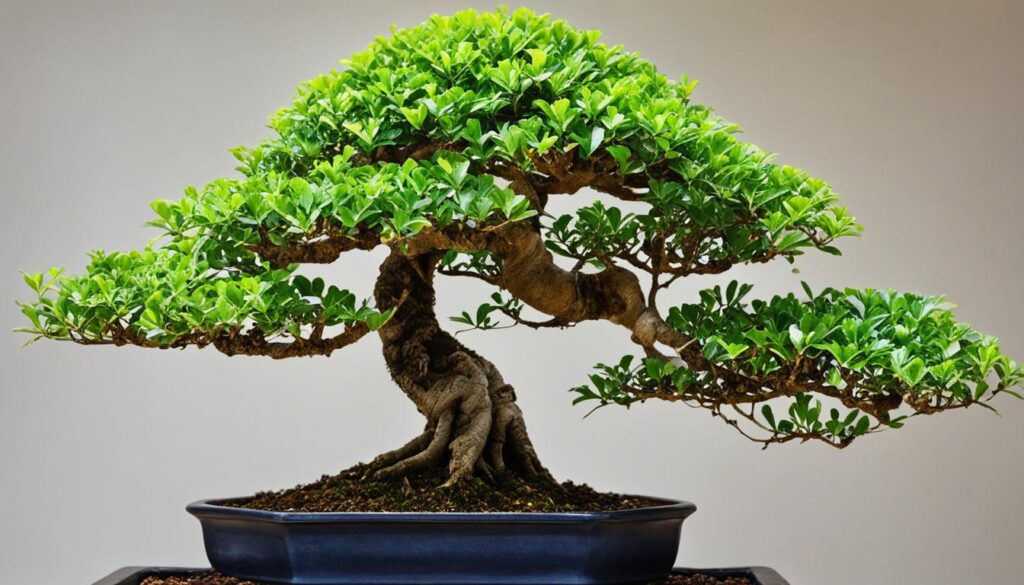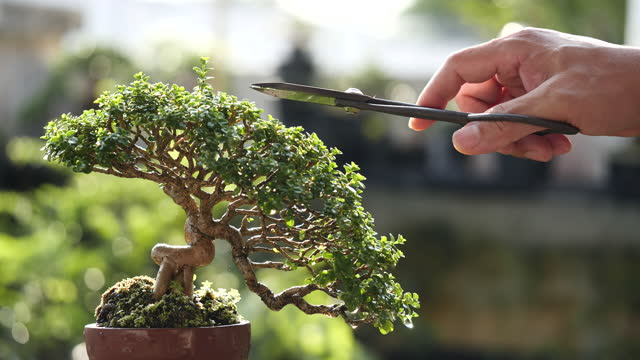Welcome to our complete care guide for Bonsai Carmona microphylla! If you have a passion for bonsai trees and are looking to cultivate a thriving indoor bonsai tree, then you’ve come to the right place. In this guide, we will provide you with all the information you need to successfully care for your Carmona microphylla bonsai tree.
Bonsai Carmona microphylla, also known as the Fukien Tea Bonsai, is a small bonsai tree that brings beauty and tranquility into any space. Its lush green foliage, delicate flowers, and intricate branching structure make it a popular choice among bonsai enthusiasts. Taking care of this bonsai tree is a fulfilling and rewarding experience, and we are here to assist you every step of the way.
In this guide, we will explore the specific care requirements of the Bonsai Carmona microphylla, including pruning techniques, watering methods, fertilization essentials, and much more. We will also cover topics such as optimal placement, wiring and training, repotting, propagating, humidity control, and pest prevention. With our guidance, you will be equipped with the knowledge and techniques to cultivate and maintain a thriving Bonsai Carmona microphylla.
Throughout this guide, we will use real examples and provide practical tips that have been proven to work. Whether you are a beginner or an experienced bonsai enthusiast, this comprehensive care guide will serve as your go-to resource for all things related to Bonsai Carmona microphylla.
So, let’s embark on this bonsai journey together. Get ready to discover the art and science behind caring for this small yet enchanting bonsai tree. With patience, dedication, and the right knowledge, you will create a breathtaking display of nature in your own home.
Understanding Your Bonsai Carmona microphylla
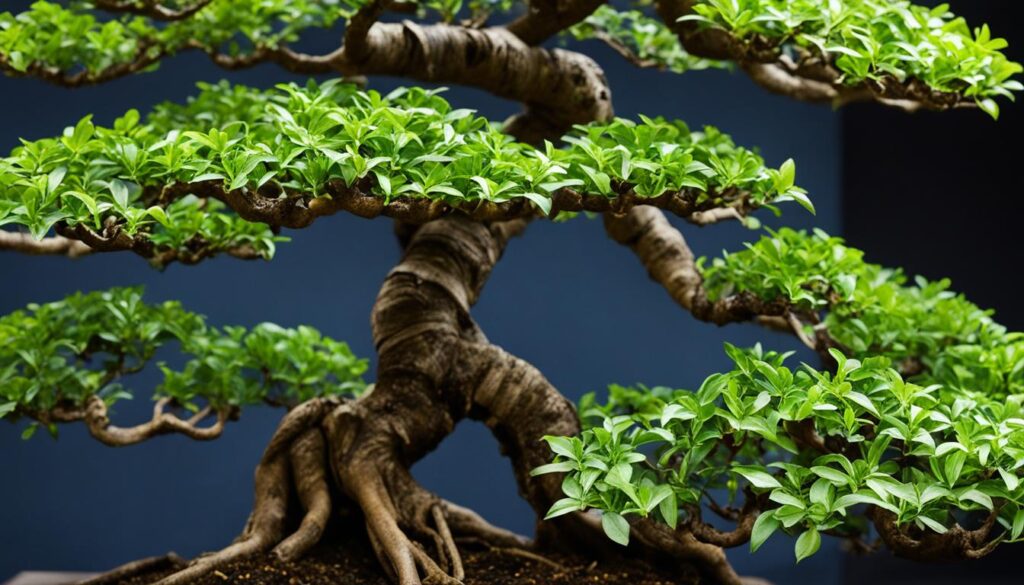
To truly care for your Bonsai Carmona microphylla, it’s essential to understand its origin and nature, as well as its distinguishing features. The Fukien Tea Bonsai, also known as Carmona microphylla, is native to parts of Japan, Indonesia, Taiwan, and Australia but gets its name from its place of origin, Fukien or Fujian, China. This evergreen shrub belongs to the Boraginaceae plant family and has small leathery dark green leaves with little white hairs on their glossy surface. Understanding the differences between Carmona microphylla and Carmona retusa, another common bonsai species, is important for proper care. We will also explore the growth habits and visual characteristics of the Carmona microphylla, including its tree structure, bark, leaves, flowers, and fruit.
The Origin and Nature of the Fukien Tea Bonsai
The Fukien Tea Bonsai, scientifically known as Carmona microphylla, derives its name from its place of origin, Fukien or Fujian, China. This evergreen shrub, belonging to the Boraginaceae plant family, is native to Japan, Indonesia, Taiwan, and Australia as well. It is highly regarded in bonsai culture for its unique characteristics and adaptability.
Distinguishing Features of the Carmona microphylla
The Carmona microphylla, known as the Fukien Tea Bonsai, exhibits a distinct set of features that make it easily recognizable. Its small leathery dark green leaves have a glossy surface and are covered with fine white hairs. The bark of this bonsai species develops a polished appearance as it ages. It also produces small white flowers that emit a pleasant fragrance, creating a captivating visual and olfactory experience.
Carmona microphylla vs. Carmona retusa
It is important to differentiate between Carmona microphylla and Carmona retusa, as they are two closely related but distinct bonsai species. While both species share some similarities, such as their small leaf siz and ability to adapt to bonsai cultivation, there are notable differences in their growth habits and visual characteristics. Understanding these distinctions will help ensure proper care for your Carmona microphylla bonsai.
Growth Habits and Visual Characteristics
The Carmona microphylla bonsai exhibits specific growth habits that differentiate it from other bonsai species. Its tree structure boasts a compact and dense appearance, making it suitable for creating aesthetically pleasing designs. The bark develops interesting textures and colors over time, adding to the tree’s overall charm. The leaves are small, dark green, and glossy, creating a striking contrast against the bark and enhancing the bonsai’s visual appeal. Carmona microphylla also produces delicate white flowers and small red or black berries, further accentuating its beauty.
Optimal Placement for Thriving Bonsai Carmona microphylla

Choosing the right placement is crucial for the thriving growth of your Bonsai Carmona microphylla. Whether you plan to keep it indoors or outdoors, there are important factors to consider to ensure its health and vitality.
If you prefer to keep your Carmona microphylla bonsai indoors, it requires ample natural light. Place it right next to a window that receives the best light, preferably facing south or southeast. This will provide the bonsai tree with the necessary sunlight it needs for photosynthesis and overall growth.
If you choose to keep your bonsai Carmona microphylla outdoors, be mindful of the temperature requirements and sunlight exposure. This bonsai tree thrives in warm climates, ideally ranging between 65°F (18°C) and 75°F (24°C). Ensure the spot you choose is warm and sheltered, protected from extreme weather conditions and strong winds.
Humidity is another crucial aspect to regulate in both indoor and outdoor environments. Bonsai Carmona microphylla prefers moderate humidity levels, between 40% and 60%. To maintain an appropriate level of humidity, consider using a humidity tray or placing a bowl of water next to the bonsai tree. This will help prevent the leaves from drying out and ensure its overall well-being.
By carefully selecting the optimal placement for your Bonsai Carmona microphylla, you are providing it with the ideal conditions to thrive. Whether indoors or outdoors, ensure it receives ample light, appropriate temperatures, and well-regulated humidity. These considerations will contribute to the health and beauty of your Carmona microphylla bonsai for years to come.
Watering Techniques for a Healthy Bonsai Plant
Proper watering techniques are crucial for maintaining the health and vitality of your Bonsai Carmona microphylla. Understanding the frequency and amount of watering required is essential to ensure optimal growth and prevent issues such as overwatering or underwatering.
Frequency and Amount of Watering
The frequency of watering your bonsai tree will depend on various factors, including the climate, season, and specific needs of the Carmona microphylla. As a general rule, it is important to allow the soil to partially dry out before watering again. This helps prevent overwatering, which can lead to root rot and other detrimental effects.
When watering your Bonsai Carmona microphylla, ensure that you thoroughly wet the soil until the water drains out from the drainage holes at the bottom of the pot. This ensures that the entire root system receives adequate moisture. Avoid shallow watering, as it may lead to uneven water distribution and root drying.
Signs of Overwatering and Underwatering
Overwatering is a common mistake in bonsai tree care that can cause root rot and fungal infections. Signs of overwatering include yellowing or wilting leaves, stagnant growth, and a foul smell coming from the soil. If you notice these symptoms, it is crucial to adjust your watering schedule and allow the soil to dry out more between waterings.
On the other hand, underwatering can also be harmful to your Bonsai Carmona microphylla. Signs of underwatering include dry, brittle leaves, drooping foliage, and the soil pulling away from the sides of the pot. If you notice these symptoms, it is important to increase the frequency of watering and ensure that the soil is adequately moist during each watering session.
Choosing the Right Water for Your Bonsai Tree
Choosing the right water for your Bonsai Carmona microphylla is crucial for its overall health and well-being. While tap water is generally suitable for most bonsai trees, it is important to consider the quality of your tap water. If your tap water contains excessive chlorine or minerals, it may be necessary to use filtered water or let the tap water sit for 24 hours to allow the chlorine to evaporate before watering your bonsai tree.
Additionally, some bonsai enthusiasts prefer using rainwater or distilled water to ensure a consistent pH level and reduce the risk of potential mineral buildup in the soil. However, it is essential to monitor the pH levels of the soil and adjust accordingly to maintain the ideal growing conditions for your Carmona microphylla bonsai.
By following proper watering techniques, identifying signs of overwatering and underwatering, and choosing the right water for your Bonsai Carmona microphylla, you can ensure the health and vitality of your bonsai tree and foster its long-term growth and beauty.
Feeding Your Indoor Bonsai Tree: Fertilizing Essentials
Fertilizing is an essential aspect of bonsai tree care, and it plays a crucial role in the health and growth of your indoor Bonsai Carmona microphylla. Providing your bonsai tree with the right nutrients will ensure its overall well-being and help it thrive.
When it comes to fertilizing your indoor bonsai tree, it’s important to choose the right fertilizers that are specifically formulated for bonsai plants. Look for a balanced fertilizer with equal amounts of nitrogen (N), phosphorus (P), and potassium (K). These macro-nutrients are essential for healthy growth and should be present in a ratio of approximately 10-10-10 or 12-12-12.
Apply the fertilizer according to the instructions provided on the packaging. The frequency of fertilization will depend on the specific needs of your Carmona microphylla bonsai, but as a general guideline, you can fertilize once every two weeks during the growing season (spring and summer) and reduce it to once a month during the dormant period (fall and winter).
When fertilizing your indoor bonsai tree, it’s crucial to follow proper guidelines to prevent overfertilization, which can harm the roots and lead to nutrient burn. Always dilute the fertilizer to half or quarter strength to avoid damaging the delicate root system of your tree.
Here are some tips to help you troubleshoot common issues related to fertilizing your indoor Bonsai Carmona microphylla:
- Nutrient deficiencies: If you notice yellowing leaves, stunted growth, or diminished flowering, it may indicate a nutrient deficiency. Adjust the fertilization schedule to provide your bonsai tree with a more frequent or higher dose of fertilizer to address the deficiency.
- Nutrient excesses: On the other hand, if you observe salt deposits on the soil surface, leaf burn, or slowed growth, it’s a sign of nutrient excess. Flush the soil with water to remove any excess salts and reduce the frequency or concentration of fertilization to prevent further issues.
Feeding your indoor Bonsai Carmona microphylla with the right nutrients through proper fertilizing techniques will contribute to its lush foliage, vibrant flowering, and overall vitality. Remember to always pay attention to the specific needs of your bonsai tree and adjust the fertilization routine accordingly.
Bonsai Tree Pruning: Timing and Techniques
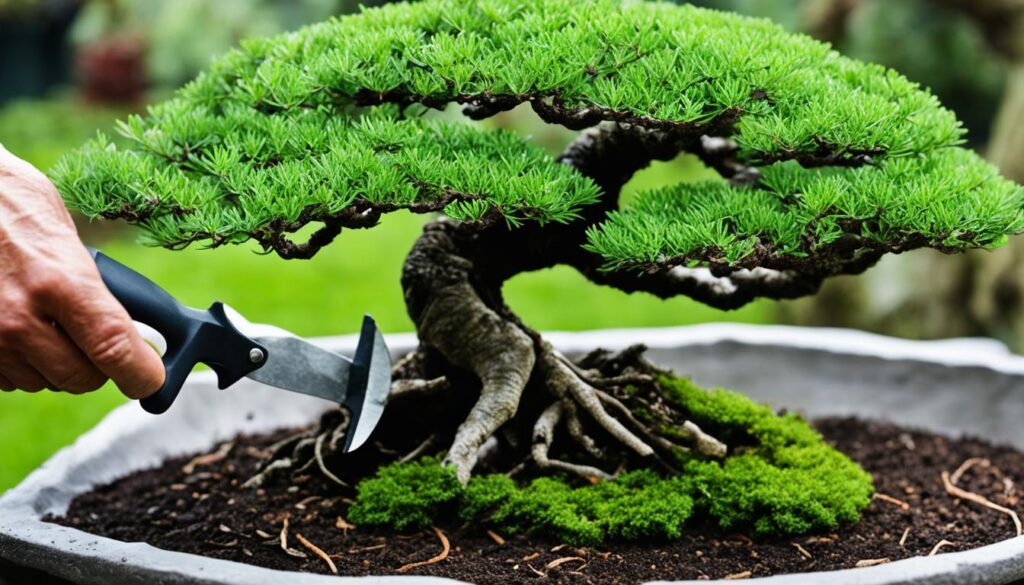
Pruning is an essential practice for maintaining the shape and health of your Bonsai Carmona microphylla. Proper pruning not only enhances the aesthetics of your bonsai tree but also stimulates new growth and prevents the emergence of unwanted branches. In this section, we will cover the timing and techniques for pruning your bonsai tree, ensuring its continued vitality and visual appeal.
Timing is crucial when it comes to bonsai tree pruning. To promote optimal growth and recovery, prune your Bonsai Carmona microphylla during its active growing season, preferably in the late spring or early summer. During this period, the tree is in its most vigorous state and can heal more quickly.
When pruning your bonsai tree, it is essential to have a clear goal in mind. Whether you aim to refine its shape, remove unwanted branches, or encourage a specific growth pattern, understanding your objectives will guide your pruning techniques.
There are different pruning methods you can employ depending on your goals:
- Pinching: This technique involves using your fingertips or bonsai scissors to pinch off the tips of new branches or shoots. Pinching promotes ramification and stimulates the growth of smaller, more compact foliage.
- Thinning: Thinning involves selectively removing certain branches or foliage to increase light penetration and improve airflow within the canopy. This technique helps prevent the development of weak or crowded branches.
- Heading: Heading pruning involves cutting back a branch to a specific point, usually just above a bud or leaf node. This technique can be used to encourage back-budding, redirect growth, or control the overall size of the bonsai tree.
When pruning, it is essential to use the right tools to ensure clean cuts and minimize the risk of injury. Bonsai-specific tools, such as concave cutters, branch cutters, and pruning shears, are designed to make precise cuts without damaging the surrounding tissue. Always sanitize your tools before pruning to prevent the spread of any potential diseases.
Remember, pruning should be approached with care and precision. Avoid removing more than one-third of the tree’s foliage at a time, as this can stress the bonsai and compromise its health. Regularly assess your bonsai tree’s growth and shape to determine the need for pruning, keeping in mind its unique characteristics and growth patterns.
Pruning is a rewarding and creative aspect of bonsai tree care. By mastering the timing and techniques for pruning your Bonsai Carmona microphylla, you can sculpt and maintain a beautiful, thriving bonsai tree that showcases the artistry of nature.
Wiring and Training Your Bonsai Carmona microphylla
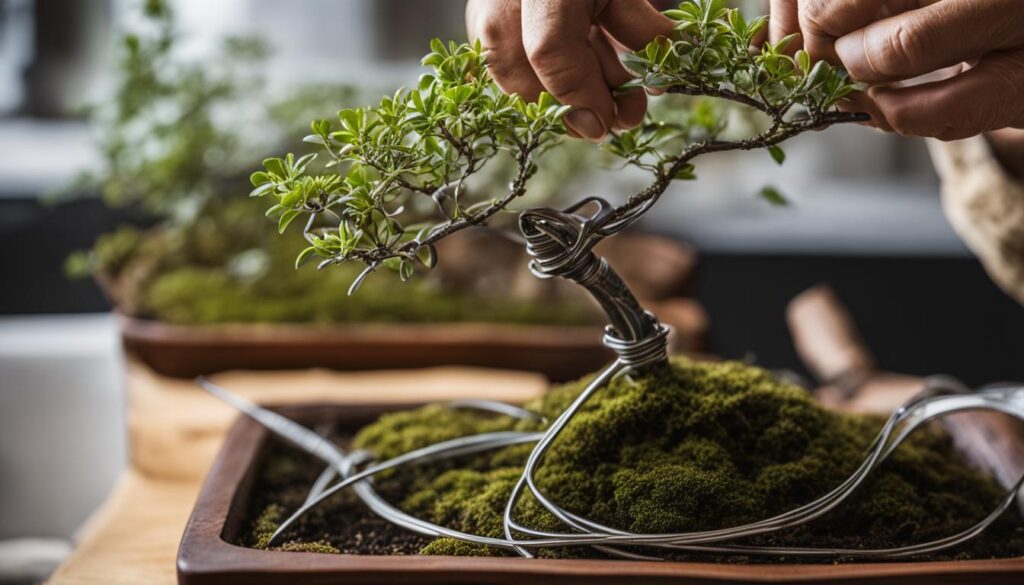
Wiring and training are fundamental techniques for shaping and guiding the growth of your Bonsai Carmona microphylla. By utilizing these methods, you can create the desired aesthetic and structure for your bonsai tree, turning it into a true masterpiece.
When it comes to wiring your bonsai tree, timing is crucial. You should wire your Carmona microphylla during the tree’s dormant period, which typically falls in late winter or early spring. This is when the tree’s branches are more flexible, allowing you to manipulate them into the desired positions. Be careful not to wire during the active growth phase, as it may cause damage to the tree.
To wire your Bonsai Carmona microphylla, follow these steps:
- Select high-quality bonsai wire that is appropriate in thickness for the size of your tree branches. Ensure that the wire is strong enough to hold the branch in place but gentle enough not to cause damage.
- Start at the base of the branch and gently wrap the wire around it, ensuring an even and consistent tension along the length of the branch. Avoid wrapping too tightly as it may cut into the bark and damage the branch.
- Continue wrapping the wire up the branch, maintaining an angle that matches the desired position.
- Once you reach the tip of the branch, twist the wire ends together to secure it in place.
- Make adjustments to the position of the branch if needed, carefully bending it to achieve the desired shape.
Important tips for successful training:
- Regularly check the wire for any signs of cutting into the branch. If you notice any indentations or pressure marks, gently loosen or remove the wire to prevent damage.
- Monitor the growth of your bonsai tree and adjust the wiring as necessary to ensure it doesn’t constrict the branches and hinder their development.
- Training is an ongoing process, and it requires patience and regular maintenance to achieve the desired results. Regularly inspect your bonsai tree and make any necessary adjustments to maintain its shape and aesthetics.
Training your Bonsai Carmona microphylla is a rewarding endeavor that allows you to customize and showcase your artistic vision. With proper wiring and training techniques, you can transform your bonsai tree into a captivating work of art.
Repotting Your Small Bonsai Tree: When and How
Signs That It’s Time to Repot
Knowing when to repot your small bonsai tree is crucial for its overall health and growth. There are several signs to look out for that indicate it’s time to repot your Carmona microphylla bonsai:
- Root congestion: If you notice roots circling around the bottom of the pot or protruding from the drainage holes, it’s a clear sign that your bonsai is outgrowing its current pot and needs a larger one.
- Nutrient deficiency: When the soil no longer provides adequate nutrients for your bonsai tree, you may observe stunted growth, yellowing leaves, or a general decline in overall health. Repotting allows you to refresh the soil and provide the necessary nutrients for your bonsai’s continued well-being.
Choosing the Correct Soil and Pot
Selecting the right soil and pot is essential for successful repotting of your Carmona microphylla bonsai:
- Soil: Use a well-draining bonsai soil mix that retains moisture without becoming overly saturated. A mix of akadama, pumice, and lava rock is commonly used for bonsai trees, providing optimal drainage and aeration.
- Pot: Choose a pot that is slightly larger than the current one, allowing room for root growth. Ensure the pot has adequate drainage holes to prevent waterlogged soil, as this can lead to root rot and other issues. Opt for a pot made of durable materials, such as ceramic or plastic, that will withstand the demands of bonsai tree care.
Minimizing Stress During the Repotting Process
Repotting can be a stressful experience for your bonsai tree, but you can minimize stress by following these tips:
- Timing: Repot your Carmona microphylla bonsai during its dormant period in early spring or late winter. This ensures that it experiences minimal disruption and has ample time to recover before the growing season.
- Gentle handling: Handle the roots and tree with care, avoiding any unnecessary roughness or damage. Gently remove the tree from the old pot and untangle any congested roots, being mindful not to break or tear them.
- Pruning: Trim back any excessively long or damaged roots before placing the tree in its new pot. This encourages the development of new feeder roots and helps maintain a balanced root-to-foliage ratio.
- Watering and aftercare: After repotting, water your bonsai thoroughly to settle the soil and promote root establishment. Place the tree in a shaded area for a few weeks to allow it to recover from any stress and gradually reintroduce it to its normal growing conditions.
| Signs That It’s Time to Repot | Choosing the Correct Soil and Pot | Minimizing Stress During the Repotting Process |
|---|---|---|
| Root congestion | Use a well-draining bonsai soil mix | Repot during the dormant period |
| Nutrient deficiency | Select a pot slightly larger than the current one | Handle roots and tree with care |
| Excess water | Ensure the pot has adequate drainage holes | Trim back excessively long or damaged roots |
| Dried or damaged leaves | Opt for a pot made of durable materials | Water thoroughly and provide aftercare |
Methods of Propagating Carmona microphylla Bonsai
Expanding your bonsai collection and sharing the beauty of Carmona microphylla bonsai with others is an exciting endeavor. There are two primary methods for propagating this bonsai tree: seed propagation and cuttings. Both techniques require specific steps and attention to detail to ensure successful propagation.
Seed propagation: Harvesting and planting seeds is one way to propagate Carmona microphylla bonsai. Follow these steps for successful seed propagation:
- Collect mature seeds from the tree during the appropriate season.
- Prepare a seed tray or small pots with well-draining soil mix.
- Plant the seeds in the soil, ensuring they are not buried too deep.
- Keep the soil consistently moist and warm.
- Place the seed tray or pots in a location with indirect sunlight.
- Monitor the moisture level and provide regular care until the seeds germinate and develop into seedlings.
- Transplant the seedlings into individual pots once they have grown several sets of true leaves.
Cuttings: Taking cuttings from existing Carmona microphylla bonsai is another effective method of propagation. Follow these steps for successful cutting propagation:
- Select a healthy branch or stem from the parent tree.
- Using clean and sharp pruning shears, make a clean cut just below a node.
- Remove any leaves from the lower half of the cutting.
- Dip the cut end into a rooting hormone powder to promote root growth.
- Prepare a well-draining rooting medium, such as a mix of peat and perlite.
- Insert the cutting into the rooting medium, ensuring that at least one node is underground.
- Mist the cutting with water and cover it with a plastic bag to create a humid environment.
- Place the cutting in a warm location with indirect sunlight.
- Maintain consistent moisture and periodically remove the plastic bag to prevent mold growth.
- Monitor the cutting for new growth and root development.
- Once the cutting has developed a strong root system, transplant it into a suitable bonsai pot.
Regardless of the propagation method you choose, patience, care, and attention to detail are key to successful propagation of Carmona microphylla bonsai. With proper techniques and nurturing, you can propagate these beautiful bonsai trees and continue to enjoy their elegance and charm.
Maintaining Proper Humidity Around Your Bonsai
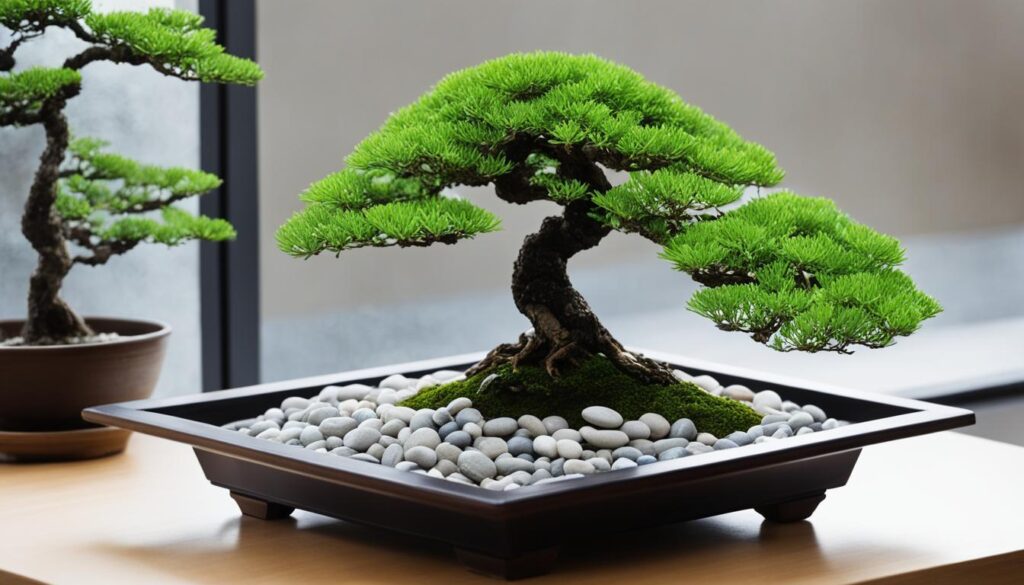
Proper humidity is essential for the health and well-being of your Bonsai Carmona microphylla. Maintaining the right moisture levels will ensure that your bonsai tree thrives and remains resistant to common issues such as leaf drying, wilting, and pest infestations. In this section, we will explore effective methods for maintaining humidity around your bonsai tree, including the use of humidity trays, monitoring humidity levels, and adjusting humidity in different seasons.
Creating a Humidity Tray
One effective way to increase humidity around your Bonsai Carmona microphylla is by using a humidity tray. A humidity tray is a shallow tray filled with water that sits beneath the bonsai pot. It helps to create a localized moist environment that mimics the natural habitat of the bonsai tree. To create a humidity tray, place a tray filled with water near your bonsai tree, ensuring that the water level is below the tray’s surface. This method provides a constant source of humidity that slowly evaporates, maintaining the ideal moisture level for your bonsai.
Monitoring Humidity Levels
Regularly monitoring the humidity levels around your bonsai tree is crucial for maintaining optimal conditions. You can use a hygrometer, a device that measures humidity, to accurately gauge the moisture in the air. Aim for a humidity level between 50-60%, as this range closely resembles the natural environment that Bonsai Carmona microphylla thrives in. By regularly monitoring the humidity levels, you can make necessary adjustments to ensure that your bonsai tree remains healthy and vibrant.
Adjusting Humidity in Different Seasons
The humidity requirements for your Bonsai Carmona microphylla may vary depending on the season. During the warmer months, when the air tends to be drier, you may need to take additional steps to increase humidity. One effective method is to mist the foliage of your bonsai tree daily using a fine mist sprayer. This helps to replenish moisture on the leaves and creates a humid microclimate around the tree. In contrast, during colder months or in more humid climates, you may need to reduce humidity levels by providing proper ventilation and reducing watering frequency.
By maintaining the proper humidity levels around your Bonsai Carmona microphylla, you will provide the ideal growing conditions for your bonsai tree, promoting its overall health and vitality. The methods discussed in this section will help you create a thriving environment that encourages healthy growth and enhances the beauty of your bonsai.
Preventing and Treating Pests and Diseases
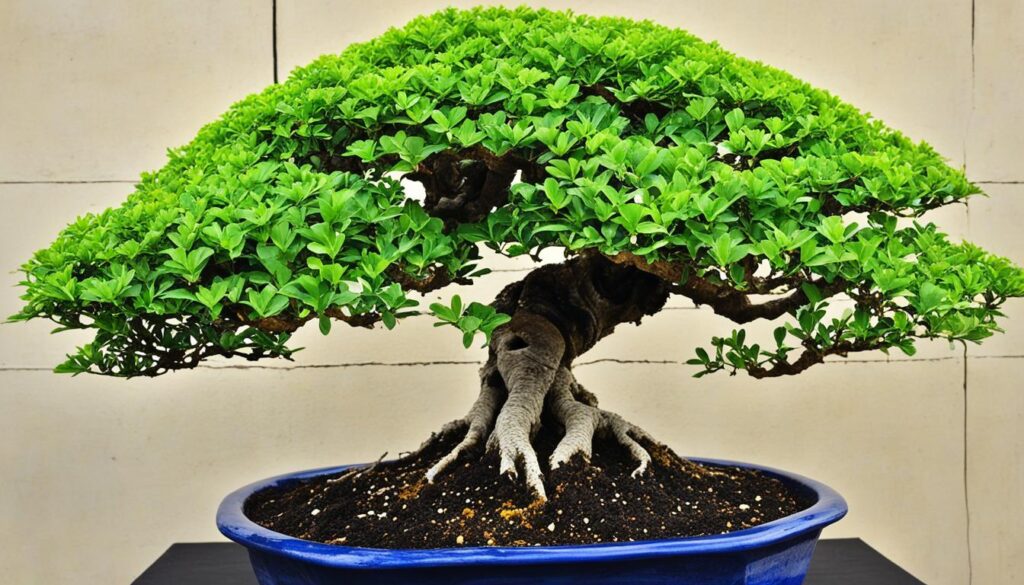
Like any other plant, Bonsai Carmona microphylla is susceptible to pests and diseases. It’s essential to implement effective strategies for prevention and treatment to ensure the long-term health of your bonsai tree. In this section, we will discuss common pests that can affect Carmona microphylla bonsai and explore both organic and chemical treatments. We will also emphasize the importance of preventive measures to maintain the overall well-being of your bonsai tree.
Common Pests That Affect Bonsai Carmona microphylla
Bonsai Carmona microphylla can be vulnerable to various pests that can potentially harm its health and appearance. These pests include:
- Aphids
- Mealybugs
- Mites
- Scale insects
- Fungus gnats
Identifying the presence of these pests early on is crucial for swift action and controlling their population.
Using Organic and Chemical Treatments Safely
When it comes to treating pests and diseases on your Bonsai Carmona microphylla, you have a range of options to choose from. Organic treatments involve using natural substances and methods to repel or eliminate pests, while chemical treatments involve the use of synthetic pesticides or insecticides. It’s important to use both organic and chemical treatments safely, following the instructions and recommended dosages provided by the manufacturers.
Organic treatments for pests often include:
- Neem oil
- Essential oils
- Soap-based insecticides
- Diatomaceous earth
Chemical treatments may include:
- Insecticidal sprays
- Fungicides
- Miticides
Select the appropriate treatment based on the severity of the infestation and your personal preferences. Always prioritize the well-being of your bonsai tree and follow the instructions carefully.
Preventive Measures for Long-Term Plant Health
Preventing pests and diseases is key to maintaining the long-term health of your Bonsai Carmona microphylla. Here are some preventive measures you can take:
- Regularly inspect your bonsai tree for any signs of pests or diseases.
- Keep your bonsai tree in a clean and well-maintained environment.
- Ensure proper watering techniques and avoid overwatering, as excess moisture can attract pests.
- Provide adequate airflow around the tree to discourage the growth of fungal or bacterial infections.
- Quarantine any newly acquired plants to prevent the introduction of pests to your existing collection.
- Monitor humidity levels and maintain optimal levels to reduce the risk of pests and diseases.
Implementing these preventive measures can significantly reduce the likelihood of pest infestations and diseases, promoting the overall health and vitality of your Bonsai Carmona microphylla bonsai tree.
Bonsai Carmona microphylla Tree Care Throughout the Seasons
Proper care for your Bonsai Carmona microphylla should be adjusted according to the changing seasons. By understanding the specific care requirements for each season, you can ensure the health and vitality of your bonsai tree year-round.
In the spring, as the temperatures start to rise, it’s important to monitor the watering of your Carmona microphylla bonsai. With increased sunlight and warmer weather, the tree’s water requirements may change. It’s essential to adjust your watering schedule accordingly, taking care not to overwater or underwater the bonsai tree. Additionally, spring is a good time to examine the soil and, if necessary, repot your bonsai to provide fresh nutrients and encourage healthy growth.
As summer arrives, your Carmona microphylla bonsai may benefit from regular misting to maintain adequate humidity levels. The intense heat and prolonged sunlight can cause the soil to dry out quickly, so be vigilant in monitoring the moisture levels and adjust your watering routine accordingly. Moreover, fertilizing your bonsai tree with a balanced fertilizer during the summer months will provide essential nutrients, promoting strong roots and vibrant foliage.
In the fall, as the temperatures start to cool down, your Carmona microphylla bonsai may enter a period of dormancy. The watering requirements may decrease, but it’s crucial to continue monitoring the soil moisture to ensure it doesn’t become too dry. Pruning can also be done during this time to shape the tree and remove any dead or diseased branches. Additionally, safeguarding your bonsai from sudden temperature drops by bringing it indoors or providing appropriate protection is essential for its survival.
During the winter, when the temperatures drop significantly, it may be necessary to move your Carmona microphylla bonsai indoors to protect it from freezing. Ensure that the bonsai receives ample light while being kept away from drafts and heating sources. Adjust your watering routine to ensure the soil remains slightly moist and avoid excessive fertilization. Periodic monitoring of the bonsai’s overall health and providing adequate humidity through methods such as using a humidity tray will help maintain its well-being.
By tailoring your care practices to the changing seasons, you can provide the optimal environment for your Bonsai Carmona microphylla to thrive. Adapting temperature, watering, fertilizing, and protection practices will promote healthy growth, encourage flowering, and support the overall well-being of your cherished bonsai tree.
This page contains some affiliate links. Please check out our affiliate disclaimer for more information

Karen Phillips, Bonsai expert and blogger. Read more about me here

